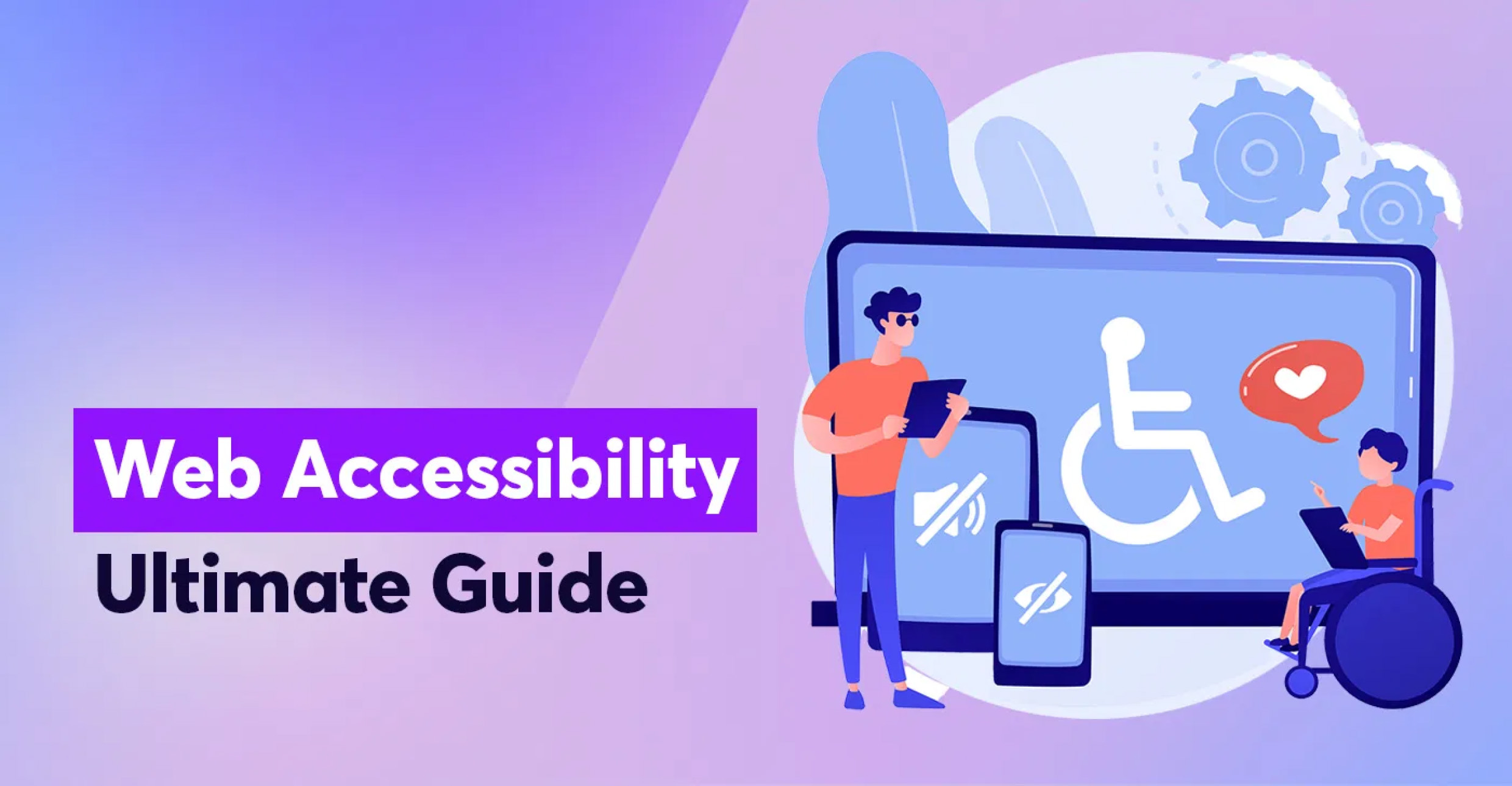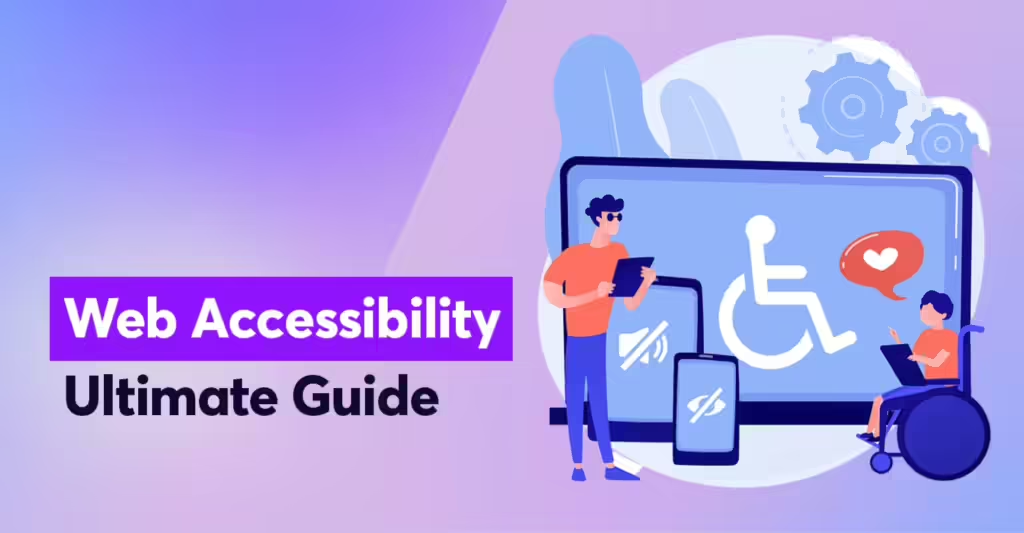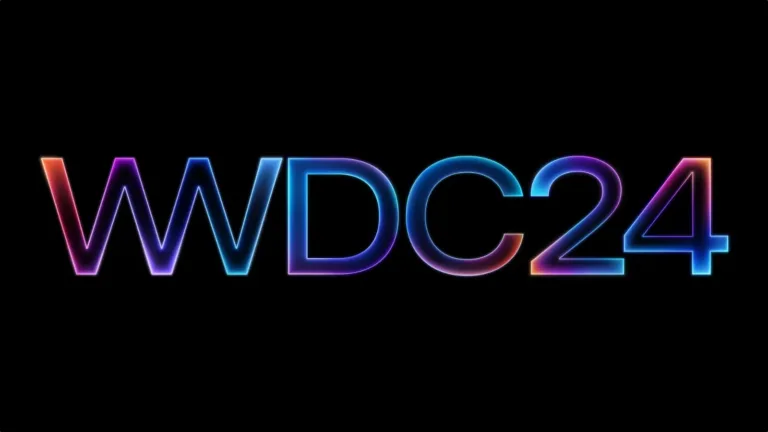Copyright © 2024 - Proudly built and managed by us.


If you’re here to learn everything there is about website accessibility and why it should matter to your business, you’re in the right place.
Making your website accessible means it will work for everyone who visits you, regardless of their abilities. Besides, there is a growing legal and ethical consideration for creating inclusive digital experiences that are accessible to all users.
That’s why in this article we’ll get into the details of what web accessibility is, its importance, and accessibility guidelines. Then, finish with some of the best practices for implementing web accessibility in web design and the legal requirements.
Throughout this post we’ll cover the following:
- What is website accessibility (and why it’s important)?
- An overview of the Web Content Accessibility Guidelines (including the key principles of WCAG)
- Tools and techniques for testing website accessibility
- Some of the best practices for implementing web accessibility
Let’s begin with what website accessibility is and its importance.
What is web accessibility?
Web accessibility is the process of building an inclusive website and digital experience so that people with disabilities can easily access and use them like the rest. For example:
- Someone who cannot hear well can follow along with videos by reading captions. Transcripts can also be made available for audio content like podcasts.

- A person with low vision can use a screen reader that reads aloud the text content and descriptions on a webpage. Descriptions like an alt text added to images.
- Users with color blindness can differentiate elements on the website through high color contrast schemes.
- People with motor impairments can navigate a website using only a keyboard or voice commands, rather than a mouse.
- Individuals with cognitive disabilities can better understand content that is presented in clear, simple language with intuitive web navigation.
Types of disabilities web accessibility encompasses
In simpler terms, web accessibility addresses all types of disabilities that affect access to your website. These include:
- Auditory: These are people who are deaf, hard of hearing, or have hearing loss.
- Visual: These are people who are blind, have low vision, or are colorblind.
- Motor: for example, users with limited movements or difficulty using a mouse.

- Cognitive disabilities: These can include learning disabilities, memory issues, or attention disorders.
- Speech: covers users who may have difficulty speaking or using voice input features.
- Neurological: This can include conditions like epilepsy, migraines, or photosensitivity.
Next, let’s find out why it’s important to make your website accessible.
Why is web accessibility important?
According to statistics from the World Health Organization (WHO), there are 1.3 billion people recorded worldwide with disabilities. These numbers are still increasing.
What does this imply?
If your website isn’t fully accessible, then people with disabilities who rely on the internet for information, goods, and services will have a hard time accessing this content. Implementing accessibility enables these visitors to get information from your website effortlessly.
There are other additional benefits you can enjoy:
It improves user experience
Accessibility features like closed captions and transcripts, easier web page navigation, clearer content, etc., benefit all users, not just those with disabilities. A well-designed, accessible website ensures that everyone can find information and use your services effortlessly. This makes the user experience smoother and more enjoyable.
There’s also the business side.
It increases your customer base
By making your site accessible, you open your business to a larger audience, including the millions of people with disabilities. You won’t miss out on these potential customers who otherwise would not be able to engage with your website.
It improves your bottom line
More visitors and a better user experience often increase sales, sign-ups, or conversions. Plus, when people find it easy to navigate and engage further with your website, they are more likely to become loyal customers. This can positively impact your revenue as well.
It boosts your SEO
Many accessibility features, like adding alt text to images and using clear, structured headings, also improve search engine optimization (SEO). This makes your website more discoverable by search engines. The result is better rankings and increased traffic.
There are web accessibility guidelines websites can easily conform in order to be on the safe side of the law as well. Here is an overview of these guidelines and what you can do.
Overview of web content accessibility guidelines (WCAG)
Web Content Accessibility Guidelines (WCAG) are internationally recognized recommendations that help web developers make their content accessible to people with disabilities.
These guidelines are developed by the World Wide Web Consortium (W3C). They focus on making websites more perceivable, operable, understandable, and robust for all users. These are the four key principles of web accessibility.
WCAG 2 is structured into three levels of conformance:
- Level A: This is the minimum level of conformance. Content that meets Level A success criteria addresses the most basic web accessibility issues, such as keyboard navigation and text alternatives for images.
- Level AA: Content that conforms to level AA criteria addresses a wider range of accessibility barriers. It includes level A criteria and ensures better usability for people with disabilities.
- Level AAA: This is the highest and most complex level of accessibility. Meeting these success criteria makes content as accessible as possible, but not all content can achieve this level.
Each level builds on the previous one such that level AAA includes the requirements from both A and AA conformance levels.
Why it’s important to meet WCAG standards
Meeting one of the three conformance levels means that all information on a web page follows WCAG 2 standards. But to be classified as fully conforming to WCAG 2, a website must also meet the following four additional conformance requirements:
- Full Pages: The entire web page, not just parts of it, must meet the success criteria.
- Complete processes: If a web page is part of a process, all web pages in the process must conform to the specified level.
- Accessibility-supported technologies: Only technologies that are supported by assistive technologies can be relied upon for conformance.
- Non-interference: The web page must not have any content or features that interfere with the operation of other accessible content.
That being said, let’s expound on the four key principles of website accessibility we mentioned earlier.
Key principles of web accessibility
The WCAG standard includes four main principles you’ll need to follow to create an accessible website: that is content must be perceivable, operable, understandable, and robust. Within each principle, there are additional guidelines you can reference and apply to your website.
Perceivable
This principle requires that information and the user interface be presented in a way that is easily detectable and understandable by all users; regardless of a user’s abilities or disabilities. This includes adding text alternatives for non-text content such as large print, braille, speech, symbols, or simpler language.
Or, prerecorded audio and video with live captions & transcriptions, audio descriptions, sign language, etc.
- Use color contrast, resizing text, images, content on hover or focus, text spacing, etc.
Operable
If a website is operable, it implies everyone can use a site’s interface and navigate easily. Particularly for those with motor impairments or limited mobility. For instance, you can make web content keyboard accessible using keyboard shortcuts for all functions so users don’t have to navigate using a mouse alone. Provide pause, stop, or hide options for automatically playing content, such as animations or video.
- Avoid designing content that could cause seizures or physical reactions.
- Provide navigation aids to help users find content and understand where they are on the website.
Understandable
This targets both your written and graphic content. It should be understandable to all users including those with cognitive disabilities or learning challenges. For example, use simple, clear language, and consistent navigation throughout the site. Users can easily follow instructions, and messages, and know where to find things without getting lost.
Robust
Finally, a website must be robust enough to work with different browsers, devices, and assistive technologies. It should be compatible with both current and future tools. One way to do this is to use a clean and well-structured HTML. Optimized code ensures that assistive technologies, like screen readers, can interpret the content correctly.
Not to mention, test the site across different platforms to ensure it works properly on various devices and browsers.
Nusite IT Consulting Limited website is a great example of a website checking most accessibility guidelines. This can be experienced by clicking on the round disability icon on the left buttom of the webpage.
Talking about tools and testing, let’s look at some of the tools and techniques you can use to test website accessibility as you improve.
Website accessibility testing tools and techniques
Using a combination of automated tools, screen readers, and manual techniques for accessibility testing can help you determine if your site meets WCAG standards.
- Automated web accessibility checkers: Tools like WAVE, Axe, and Lighthouse automatically scan web pages for accessibility issues. They identify problems such as missing alt text, poor color contrast, or improper heading structure.

Although these tools are fast and efficient, they may not catch every issue with accessibility. Therefore, they are best used alongside manual testing methods.
- Manual testing methods: This technique allows you to check what automated tools might have missed manually. For example, you can manually navigate the site using only a keyboard to see if everything works without a mouse. Or reading through content to ensure instructions are clear and easy to understand.
- Screen readers: Testing with screen readers like NVDA or JAWS can help you evaluate how accessible your site is for visually impaired users. These tools read the content aloud and allow users to navigate using keyboard commands. Doing this simulates the experience of those relying on assistive technology.

These three methods cover all aspects of accessibility and guarantee compliance.
Best practices for implementing web accessibility
Generally, WCAG offers specific guidelines for each principle we mentioned. We’ve put together this quick web accessibility checklist and best practices based on the WCAG principle to help you jumpstart creating inclusive websites as soon as possible.
Provide text alternatives for non-text content
Use alt-text descriptions for every image. But keep it short, specific, and sweet. Infuse keywords but don’t overstuff. Doing this will allow screen readers to convey the image’s purpose to visually impaired users.
At the same time, you can add captions and transcripts for videos and audio content. Other best practices include:
- Creating accessible media, for example, by adding audio descriptions.
- Use clear layouts. For example, structure your content with proper headings (H1, H2, H3) for easy navigation like this”

- Ensure your text content is easily readable. Consider spacing, typography, avoiding all caps, resizing, choose accessible fonts like Tahoma, Calibri, Lato, raleway, etc.
- Make sure content is available in multiple formats (e.g., text, audio) when possible.
Make your site fully navigable via a keyboard
Enabling keyboard navigation can help ensure all users can navigate and operate interactive elements e.g., buttons, links, forms, etc operated using just the keyboard. Other simple steps that make a website operable include:
- Design for seizure safety. For instance, avoid using any content that flashes more than three times per second to prevent seizures.
- Use descriptive links: e.g., “Learn more about accessibility” instead of “Click here”) so users understand where the link leads.
- Allow users to pause, stop, or adjust moving content e.g., slideshows, auto-updating content.
Don’t use color only to convey information
Avoid relying on color as the only way to portray information. For example, don’t use red to indicate an error without additional text. Give some consideration to your color schemes to assist users with color blindness.
Build a clear site navigation plan

The idea behind this is pretty basic: good navigation makes it easy for people to find the information they need. Bad navigation, on the other hand, can leave users confused and lost.
- Use a consistent structure and navigation system across all pages.
- Use clear and simple language. Provide definitions or explanations for unusual words or jargon.
Write clear and actionable error messages in plain language
Error messages help users avoid mistakes. So, keep them short and simple. Don’t overuse error messages and put them in the correct format, like a modal dialogue box.
- Allow users to review and correct their input before submission.
- Give directions so the user knows what to do in case of an error or offer a solution.
Use clean and structured code
A well-structured HTML/CSS to work with easily different browsers and assistive technologies easily. Ensure that all user interface components have appropriate names, roles, and values for assistive technologies to interpret accurately.
Create accessible forms
Some of the common ways you can design accessible forms include.
- Create clear form fields that are properly labeled.
- Using larger font sizes for labels and instructions to make them easier to read
- Use contrasting colors for labels and form fields
- Structure the form logically. Group related fields to make it easier for users to fill out the form correctly.
Use a website accessibility software
Sometimes, these web accessibility best practices can feel overwhelming unless you use software like UserWay.
It embeds an accessibility widget directly into your Brizy Cloud website. It provides features like text enlargement, contrast adjustment, screen reader compatibility, keyboard navigation, highlighting links, and other elements to improve usability.

UserWay also includes automated tools to scan for and fix accessibility issues in compliance with standards like WCAG, ADA, and Section 508. It’s widely used to improve accessibility so you don’t have to overhaul the entire website.
Nusite IT Consulting Limited helps businesses with developing accessible websites quickly by integrating with accessibility software like UserWay or WP Accessibiltiy. We ensure we stick to best practicing during the start of the website to meet all accessibiltiy guidelines.
Note: Read this guide on mastering website accessibility for detailed information.
By following these guidelines, you can ensure that your website conforms with the four major WCAG principles: perceivable, operable, understandable, and robust.
Does web accessibility have legal implications?
Web accessibility is not only a best practice for inclusivity. It’s also a legal requirement in many countries now. Failing to comply with the web accessibility standards can lead to legal actions, fines, and reputational damage. The following are the major regulations that enforce web accessibility.
Americans with Disabilities Act (ADA) – U.S.

The ADA is a U.S. law that prohibits discrimination against individuals with disabilities in the physical and digital spaces. Digital spaces like technologies and websites for businesses, government entities, transportation, places of entertainment, etc. Non-compliance can result in lawsuits, financial penalties, and mandatory corrective actions.
Big brands like Netflix and Domino’s Pizza have already faced legal action for non-compliance.
European Accessibility Act (EAA) – European Union
The European Accessibility Act requires digital products and services to be accessible to people with disabilities across EU member states. This includes websites, mobile apps, ecommerce platforms, and other online services.
What’s the risk of non-compliance?
Organizations that fail to comply with the EAA can face fines, legal sanctions, or be forced to withdraw non-compliant digital services from the market. Overall, accessibility conformance is a requirement for online businesses to operate across the EU.
Other international standards (WCAG, Section 508)

Source: infosys.com
Again, WCAG is the global standard for web accessibility and is referenced by many national laws. Ensuring your website complies with WCAG 2.1 or WCAG 2.2 levels A or AA can help reduce legal risks.
Note: It isn’t recommended that Level AAA conformance be required as a general policy for an entire website. It’s nearly impossible to satisfy all Level AAA conformance criteria for some content.
Section 508 of the Rehabilitation Act in the U.S. mandates that federal agencies and institutions make their websites accessible. Private businesses working with government contracts are also required to comply with these standards.
Conclusion
The main goal of website accessibility is to make your site work for people with disabilities too. They can access, use, and enjoy the benefits of a website that is easy to navigate, read, and understand like the rest.
By implementing web accessibility guidelines and best practices, you can ensure everyone feels welcome on your site while enhancing the overall experience for everyone. You’ll enjoy other benefits in terms of better SEO performance, wider reach, and more conversions.
However, accessibility is an ongoing effort that requires continuous improvement as technology and user needs evolve.
So, start by making your site accessible by contacting us today. We are committed to regularly refining your online presence keeping it usable for everyone.
Source: Brizy Page Builder


